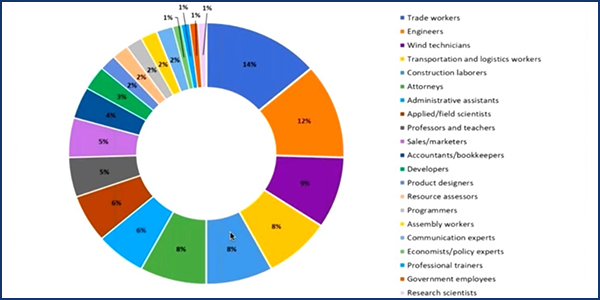Michael Hanson has been in the wind energy workforce for 14 years. He started onshore, managing the operation, maintenance and repair of turbines at a number of sites before moving to the first offshore wind farm in the Western Hemisphere, the 5-MW facility off Block Island, R.I.
It takes a diverse village to run a successful wind farm, according to Hanson.
“You can cast a wide net and get good people from a variety of backgrounds,” said Hanson, operations and maintenance manager for GE Renewable Energy.
Hanson was part of a panel at the American Wind Energy Association 2020 Offshore Windpower Virtual Summit Tuesday that discussed the education and training needed to prepare the American wind energy workforce of the present and future.
Marjaneh Issapour, an electrical engineering professor and director of the Renewable Energy and Sustainability Center at Farmingdale State College in New York, said there are many different areas of expertise and credentials needed to “fully deploy the wind energy workforce in the United States.”
Issapour said about 47% of jobs in the field are entry-level, open to high school graduates or those who have completed apprenticeships or associate degrees. Another 41% require a bachelor’s degree, with only 12% requiring a master’s or doctorate.
Among the two job titles in most demand are wind technicians, representing 9% of the total, and wind engineers, representing 12%. “Wind engineer is a multidisciplinary expertise that is a cross … of mechanical, electrical and possibly civil engineering,” she said.
Nuria Soto, senior director of offshore operations for Avangrid Renewables, said 20 years ago there were no offshore wind technicians, and “now it’s an established industry” that is also moving very fast and also needs workers for OSW development, construction and operations.
“One of the main challenges is to ensure that the workforce is ready, and the supply chain is ready,” Soto said. “All these jobs will support the different phases of each project.”
In another panel, Mark Mitchell, director of generation projects for Dominion Energy, said the industry is generating an increasing number of jobs today.
This summer, Mitchell said, Dominion had more than 25 vessels operating with more than 400 people working on the utility’s two-turbine pilot project, now in operation, and early work on its 2.6-GW commercial-scale project.
“We’ve got several hundred [people] working today offshore. It’s not just something in the future. It’s kind of here and now, creating many, many jobs,” Mitchell said.
Bruce Gresham of the International Marine Contractors Association said there’s “a mix of different levels of experience” needed to work on OSW facilities. Gresham added that tens of thousands of workers in the offshore oil and gas industry laid off during the COVID-19 pandemic have that kind of baseline experience.
“The younger generation is much more interested in working for the wind industry than the dirty oil industry,” he said.
Soto said Avangrid’s internships are a good opportunity to see how a project is developed and understand different roles.
Hanson said the best training from his perspective is to come from an onshore facility. OSW turbines are “the biggest, most technologically advanced in the world, and having that experience on the smaller machines, I think is second to none.”
That does not diminish other experience, Hanson added.
“There [are] so many different jobs that are going on within a turbine — you can come from being an electrician or technician or a mechanic or someone from the oil and gas industry, or of course from another renewable energy field or utility,” said Hanson, who also mentioned technical college and military training.
“The maintenance and construction of generators at heights in a marine environment is a new industry,” said Andy Goldsmith, a technical adviser for IMCA. “But marine construction and going to sea … is not a new industry. Lighthouses and such … have been constructed for eons, let alone the oil and gas industry, which of course started back in the [19]60s.”








